How Do You Change Your Facebook Language to English Again
How to change the default language of an Internet browser
Updated: 03/thirteen/2021 by Figurer Hope
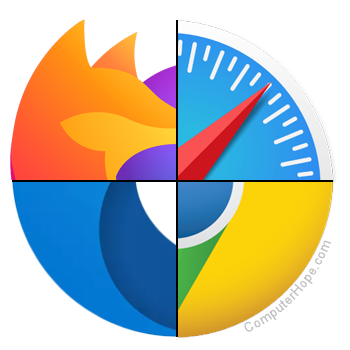
Past default, the Internet browser linguistic communication is regional; wherever you are in the world, your browser displays the language that is predominantly spoken in that location. Still, some individuals speak languages in addition to their native natural language and prefer one over the other. To change the default language displayed in an Net browser, brand a selection from the list below and follow the instructions.

Google Chrome
- Open the Google Chrome browser.
- In the upper-correct corner of the window, click the
 icon.
icon. - From the drop-down menu that appears, select Settings.
- In the side by side window, scroll to the bottom and click the
 drop-down.
drop-down. - Coil down to the Languages section and click the down arrow on the correct side of the Linguistic communication option.

- In the bill of fare that appears, click the
 link.
link. - In the next screen, click the checkbox next to one or more language(s) (A), and then click the Add push button (B).
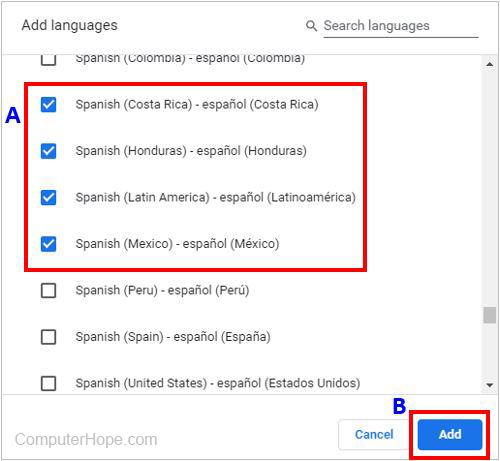
- Your newly selected languages should appear in the Language menu. To cull ane, click the
 icon to the right of the language and check the box next to Display Google Chrome in this language.
icon to the right of the language and check the box next to Display Google Chrome in this language.
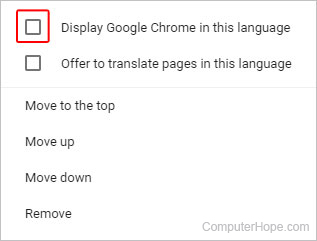
- You can click Relaunch or close and reopen your Chrome browser to display the new linguistic communication.

Mozilla Firefox
- Open the Mozilla Firefox browser.
- Click the
 icon in the upper-left corner of the browser window.
icon in the upper-left corner of the browser window. - Select
 from the drop-downwardly menu that appears.
from the drop-downwardly menu that appears. - Under the Languages and Advent section, click the
 push button.
push button.

- In the window, click the arrow on the correct side of the box (A) that says Select a language to add, and then click the
 button (B).
button (B).
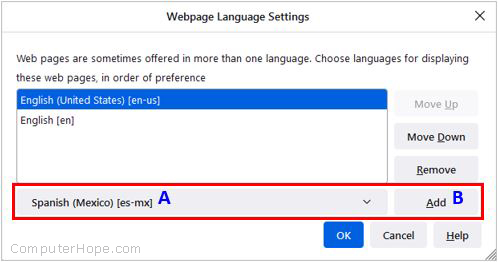
- Click the newly selected language (A), then click the OK button (B).
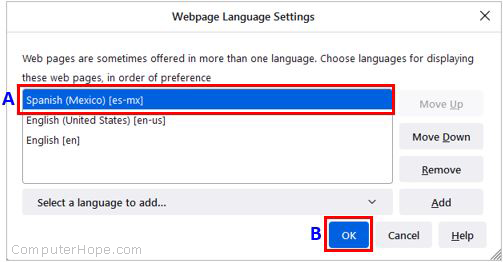
- Restart your browser to display the new linguistic communication.

Microsoft Edge
- Open the Microsoft Border browser.
- Click the Settings and more icon
 in the upper-right corner of the browser window.
in the upper-right corner of the browser window. - In the driblet-downwardly card, about the bottom, select Settings.

- On the left side of the screen, under Settings, click the Languages selector.
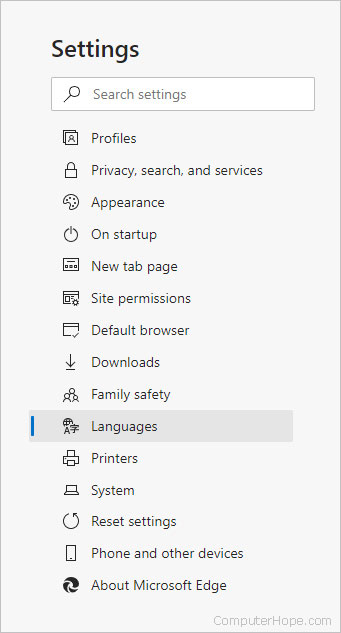
- Under the Languages department, click the Add together languages push button.
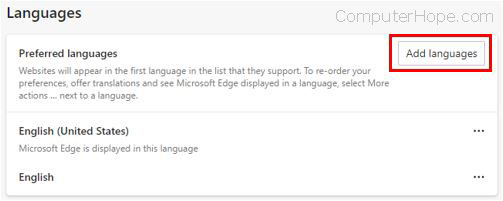
- In the prompt that appears, choose the language(s) you'd similar the browser to display, and and then click the Add button.
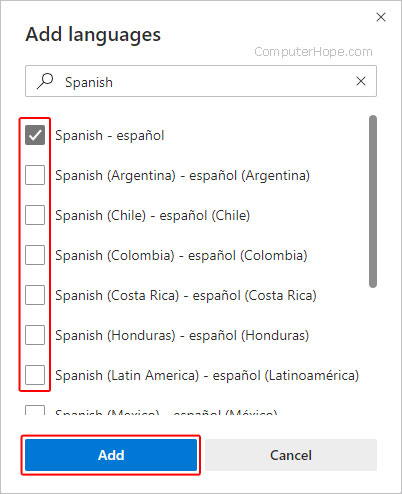
- Back in the Languages section, locate your preferred language and click the
 icon on the right side. And then, check the box adjacent to Display Microsoft Edge in this language.
icon on the right side. And then, check the box adjacent to Display Microsoft Edge in this language.
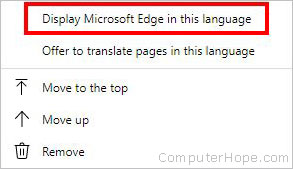
- Click the
 push button or close and reopen the browser.
push button or close and reopen the browser.

Microsoft Edge Legacy
Note
As Microsoft Edge Legacy is integrated into Windows ten, changing its default language affects some Windows programs also.
- Press the Windows key, type Regional & language settings, and printing Enter.
- In the window that appears, click the
 icon.
icon.
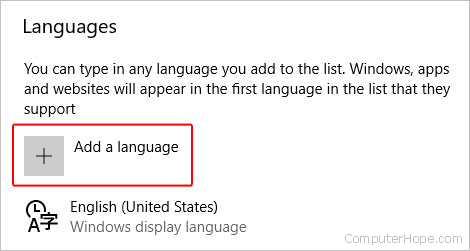
- Type a language to add or select 1 from the listing.
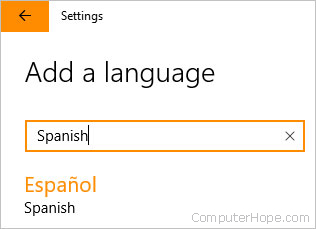
- Afterward you select a language, y'all are asked to choice a region.
- You should now see the new language in the Languages department.
- Click the new language and select the
 button.
button. - In the window that opens, under Language options, click the
 button.
button. - One time the new language is downloaded, return to the previous screen.
- Click the new language again, and so click the Set equally default button.

- Log out and dorsum in to Windows or restart your computer to brandish the new language.

Microsoft Internet Explorer
- Open Microsoft Cyberspace Explorer.
- In the upper-right corner of the screen, click the
 icon.
icon. - Select Net options from the drop-downwards menu that appears.

- In the window that opens, under the General tab, click the
 button.
button. - In the Language Preference window, click the
 button.
button. - In the Language window that appears, most the center, click Add together a linguistic communication.
![]()
- Select a new language from the Add together languages window, then click the
 button.
button. - When y'all're taken back to the Languages window, click your new language. When it turns blue, click Options on the right side.

- Select Download and install language pack.

- Click Options again and and then select Make this the principal language.

- Log out and dorsum into Windows or restart your computer to display the new language in Internet Explorer.

Safari
Safari is integrated into the macOS. Consequently, you need to go into your Mac linguistic communication settings to change the linguistic communication displayed in Safari.
- In the upper-left corner of the screen, click the Apple icon to open the Apple menu and choose System Preferences.

- Click the Language and region icon in the Arrangement Preferences window.
![]()
- In the Language & Region menu, under Preferred languages, click the + sign at the bottom.

- In the drop-downwardly menu, select a language, and and so click the Add together button.

- Yous should be prompted to switch to the new language. If non, click-and-drag the new language to the top of the menu on the previous screen (shown in step three).

- Click the Restart Now button for the new linguistic communication settings to have full effect.


Opera
- Open the Opera browser.
- In the upper-left corner of the screen, click the
 push button.
push button. - Select Settings from the drop-downward card.
- In the window that appears, on the left side, brand certain Browser is selected.

- In the Languages section, nether Select user interface language, click the blueish down arrow and select your preferred linguistic communication.

- The newly-selected linguistic communication is displayed upon restarting the Opera browser.
wakefieldlifecyll.blogspot.com
Source: https://www.computerhope.com/issues/ch001904.htm
0 Response to "How Do You Change Your Facebook Language to English Again"
Post a Comment